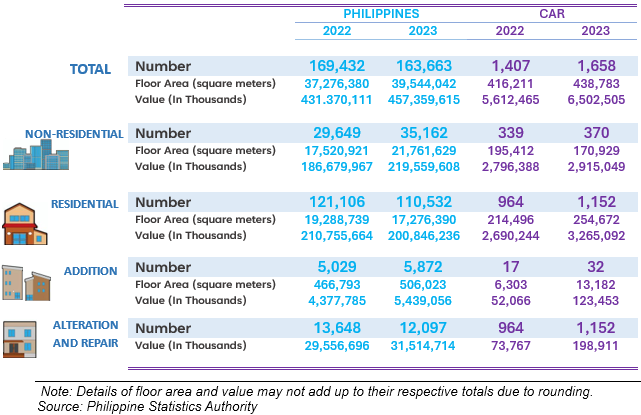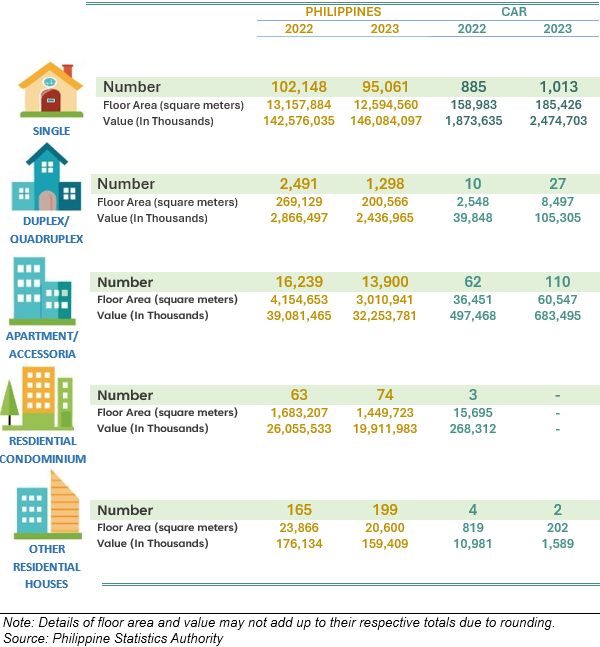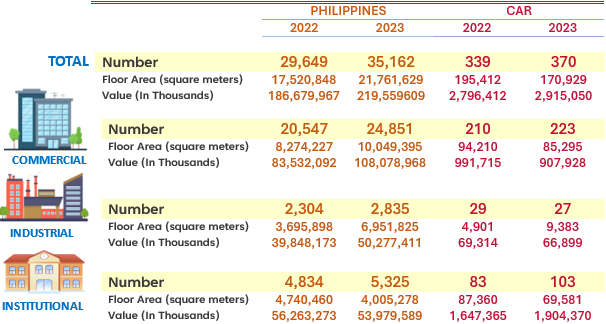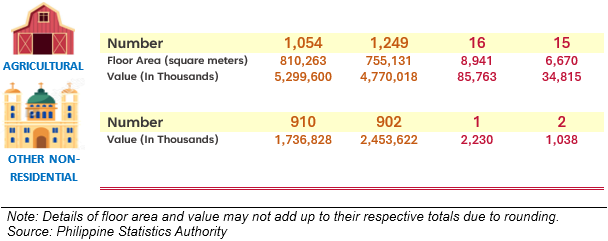Construction statistics presented in this Special release are based on the approved building permits on new constructions, additions, and alterations and repairs of existing residential and non-residential buildings, and other structures which are proposed to be constructed in different cities/municipalities of the region. Construction statistics from approved building permits aim to provide administrative data on building constructions at the regional level Statistics generated include the number of units/buildings, floor area of the buildings, types of construction, and value of construction.
Number of constructions increases by 17.8%
In 2023, the number of constructions from approved building permits in the Cordillera region reached 1,658 with a total floor area of 438,783 square meters. This increased by 17.8%, or 251 more building permits from 1,407 (floor area of 416,211 square meters) in 2022.
The total floor area covered increased to 22.6 thousand square meters which corresponds to a 5.4% increment equal to 12.2 thousand square meters. Further, the value of construction also increased to PhP 6.5 billion, or by 15.9% which is equivalent to PhP 890.0 million (Table 1).
Residential buildings record highest number of constructions
By type of construction, residential building had the highest number with 1,152 of the total number of constructions in 2023. This type of construction increased by 19.5%, equivalent to 188 units or from 964 in 2022. The value of residential building constructions amounted to PhP 3.3 billion with a covered floor area of 254.7 thousand square meters. The trend was in contrast with the national level of 110,532 permits approved in 2023, representing -8.7% or equivalent to 10,574 less construction permits compared to 2022.
Meanwhile, non-residential buildings in the region ranked second with total constructions of 370 in 2023. This indicated an increase of 9.1% from the previous year, which was equivalent to 31 additional approved building permits. The same pattern was noted at the national level with 35,162 approved building permits. This indicated an increase of 18.6% or equivalent an additional 5,513 non-residential building permits from the 29,649 permits approved for construction in the country in 2022.
Alteration and repair came third with 104 approved constructions, indicating an increase of 19.5%, corresponding to an addition of 17 more building permits compared to the previous (Table 1).
Residential buildings have highest value of construction
In 2023, the value of building constructions in the Cordillera contributed 1.0% to the national value which accounted for PhP 6.5 billion. It expanded by 19.9% or equal to an increase of PhP 890.0 thousand compared to that of 2022 (Php 5.6 billion).
Among all types of constructions, residential buildings made up the largest portion of construction with approved building permits equal to 1.6%, and with a total value of PhP 3.3 billion. This was followed by non-residential construction valued at PhP 2.9 billion. Meanwhile, alteration and repair contributed the least with PhP 198.9 million, remarkably increasing by 169.6% from that of 2022 value of PhP 73.7 million (Table 1).
Residential constructions account for more than half of total regional floor area
In 2023, the region’s total covered floor area of approved building permits was 438.8 thousand square meters. This corresponds to an increase of 5.4% from that of 2022, larger by a floor area of 22.5 thousand square meters.
Residential building permits recorded a total floor area of 254.7 thousand square meters, equivalent to 58.0% of the total floor area of approved building permits in the region, and an increase of 18.7% more buildings approved for construction compared to the previous year.
Meanwhile, non-residential construction recorded a floor area of 170.9 thousand square meters. This had an annual decrement of 12.5%, equal to 24.5 thousand square meters from that of 2022 (Table 1).
Table 1. Construction Statistics from Approved Building Permits
by Type, Philippines and CAR: 2022 to 2023

In 2023, the total value of construction in the country amounted to PhP 557.4 billion of which, 43.9% equal to Php 200.8 billion was contributed by residential constructions. The Cordillera region’s share to the value of residential constructions was 1.6%. Meanwhile, the region shared 1.3% to the value of non-residential constructions, 2.3% on additions, and 0.6% on alterations and repairs, respectively (Figure 1).
Figure 1. Contribution on the Value of Construction to the National Value by Type,
CAR: 2022 and 2023 (In Percent)

Single-type houses post highest in terms of number of constructions, floor area covered, and value
By residential type of construction in CAR, single houses posted the highest number with a total of 1,013 units in 2023 with total floor area of 185.4 thousand square meters, and total value of PhP 2.5 billion. Approved permits went up by 128 units of construction equivalent to an increase of 14.5% from the previous year.
In terms of floor area covered, single house construction which recorded 185.4 thousand square meters in 2023 showed an increase of 16.6%, equivalent to 26.4 thousand square meters. Likewise, the value for the single house construction registered the highest with PhP 2.5 billion. The value of construction for single houses increased by 32.1% or an additional PhP 600.1 million worth of construction value (Table 2) compared to 2022.
Number of duplex/quadruplex type of residential units increase
In 2023, duplex/quadruplex houses increased from 10 (2.5 thousand square meters) in 2022 to 27 units (8.5 thousand square meters) in 2023. Floor area covered increased by 5.9 thousand square meters from the previous year. The value of construction of this type of residential unit was PhP 105.3 million.
Apartment/Accesoria posts higher number of constructions, floor area covered, and construction value
In 2023, apartment/accessoria type of residential construction went up in terms of the number, floor area covered, and value of construction. A total of 110 building permits with this type of residential unit were approved for construction in 2023 with a total of 683.5 thousand square meters. These were valued at PhP 129.2 million. Approved permits for this type of construction went up by 77.4% equivalent to 48 apartments/accessoria (Table 2).
Meanwhile, there were no proposals for the construction of residential condominiums in 2023 as compared to 3 building permits approved in 2022.
Table 2. Residential Construction by Type, Philippines and CAR: 2022 and 2023

Commercial buildings record higher number of constructions with lesser floor area
In 2023, a total of 223 commercial building permits were approved in CAR. This was an increase of 6.2% from the previous year. In contrast, the floor area decreased by 9.9%, equivalent to 8.5 thousand square meters less than the previous year. In terms of value, the commercial building constructions were valued at PhP 907.9 million, a decrease of 8.4% equivalent to PhP 83.8 million (Table 3).
Industrial and Institutional constructions decrease
A total of 27 industrial buildings were approved for construction in 2023. This dropped by 6.9% equivalent to two (2) buildings as compared to the previous year. However, the floor area covered increased by 91.5% equivalent to 4.5 thousand square meters, while the value of construction declined by 3.5% indicating a decline of PhP 2.4 million.
Meanwhile, institutional buildings went up to 103 or by 24.1% from the 83 institutional buildings with approved construction permits in 2022. The floor area covered by these permits was 69.6 thousand square meters and was valued at PhP1.9 billion, an increase of 0.16% from the previous year’s value of PhP1.6 billion (Table 3).
Agricultural buildings increase
In 2023, a total of fifteen (15) agricultural buildings were approved with 6.7 thousand square meters of floor area covered. This decreased by 6.3% or from sixteen (16) approved agricultural buildings in 2022. Floor area also decreased by 59.4% or lesser by 50.9 thousand square meters (Table 3).
Table 3. Non-Residential Construction by Type, Philippines and CAR: 2022 and 2023


(SGD)
VILLAFE P. ALIBUYOG
Regional Director
Technical Notes
Building permit is a written authorization granted by the LBO to an applicant allowing him to proceed with the construction of a specific project after plans, specifications, and other pertinent documents have been found to be in conformity with the National Building Code (PD 1096).
Building refers to any independent, free-standing structure comprised of one or more rooms or other spaces, covered by a roof and enclosed with external walls or dividing walls, which extend from the foundation to the roof.
Construction refers to all on-site work done from site preparation, excavation, foundation, assembly of all the components and installation of utilities, machineries, and equipment of buildings/structures.
Residential building is a building for which its major parts or more than half of its gross floor area is built for dwelling purposes. This type of building can be of the single type, duplex, apartment and/or accessoria, and residential condominium.
Single house is a complete structure intended for a single family or household, i.e., bungalow, 2-storey house, nipa hut, etc.
Duplex house is a structure intended for two households, with complete living facilities for each; it is a single structure divided into two dwelling units by a wall extending from the floor to the ceiling.
Apartment is a structure, usually of two storeys, made up of independent living quarters, with independent entrances from internal walls and courts.
Accesoria is a one or two-floor structure divided into several dwelling units, each dwelling unit having its own separate entrance from the outside.
Residential condominium is a structure, usually of several storeys, consisting of multiple dwelling units.
Other residential construction consists of school or company staff houses, living quarters for drivers and maids, and guardhouses.
Non-residential building includes commercial, industrial, agricultural, and institutional buildings.
Commercial buildings refer to office buildings and all buildings which are intended for use primarily in wholesale, retail, and service trades, i.e., stores, hotels, restaurants, banks, disco houses, etc.
Industrial buildings are buildings used to house the production, assembly, and warehousing activities of industrial establishments, i.e., factories, plants, mills, repair shops, machine shops, printing press, storage plants, electric generating plants.
Institutional buildings are buildings which primarily engaged in providing educational instructions and hospital/health care; ports, airports and other government buildings, i.e., schools, museums, libraries, sanitaria, churches, hospitals.
Agricultural buildings are buildings used to house livestock, plants, and agricultural products such as barns, poultry houses, piggeries, stables, greenhouses, and grain mills.
Other non-building constructions include cemetery structures, street furniture, waiting sheds, communication towers, etc.
Addition refers to any new construction which increases the height or area of an existing building/structure.
Repair is a remedial work done on any damaged or deteriorated portion/s of a building/structure to restore its original condition.
Renovation is any physical change made on structures to increase their value and quality.
Alteration is a construction in a building/structure involving changes in the materials used, partitioning and location/size of openings, structural parts, existing utilities, and equipment but does not increase the overall area thereof.
Conversion is a change in the use or occupancy of structure or any portion thereof, which has different requirements.
Demolitions refer to the systematic dismantling or destruction of a building/structure, in whole or in part.
Street furniture are street structures consisting of monuments, waiting sheds, benches, plant boxes, lampposts, electric poles, and telephone poles.
Floor area of building refers to the sum of the area of each floor of the building measured to the outer surface of the outer walls including the area of lobbies, cellars, elevator shafts, and all communal spaces in multi-dwellings. Areas of balconies are excluded.
Total value of construction refers to the sum of the cost of building, electrical, mechanical, plumbing, and others. The value is derived from the approved building permit and represents the estimated value of the building or structure when completed.

